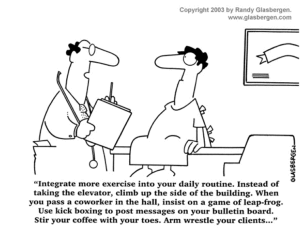|
Whoa... tell me that summer didn't fly by this
year! It's back to school for the students already and just about
time to put away the shorts and bathing suits for the rest of us. So were
you happy with your physique in that bathing suit this year? No?
What do you want your body to look like next summer? If you have an
idea of what changes you want to make, then you are on your way to setting
a long term goal for next year!
Don't wait until May or June to cram for this
test! If you are serious about getting more fit, looking better,
feeling healthier and having more energy then make the commitment now!
Besides the fact that you will be able to benefit from improved health and
fitness that much sooner, it is much easier to obtain a long term goal by
breaking the goal into smaller, more manageable, pieces or short term
goals. Having smaller short term goals is also less intimidating,
makes it more likely for you to achieve these goals, and therefore makes
it more likely for you to see results and maintain the motivation
necessary for you to keep up this lifestyle change.
For safety purposes, in addition to motivation
and adherence, it is recommended that weight loss goals be between 1 and 2
pounds per week. So with 9 months until next summer, or 36 weeks,
you have the potential of safely shedding 36 to 72 pounds!... providing
you do it the right way through proper nutrition and exercise.
Sure... you can't be expected to be THAT good all year with Christmas
cookies, Halloween and Easter candy, and the occasional birthday... but as
long as you don't make a habit of it, get back to the program, and commit to your
SMART goals, you should have plenty of
time to get to where you want to be.
So how should you start? For long term
goals of maintaining your success once it is achieved, it is important to
maintain exercise along with a sensible diet. Lets look at the
average facts: 3,500 calories is roughly equal to 1 lb of body fat.
Most moderate
cardio exercises will
burn 200-300 calories per 30 minutes while you are
exercising. So by creating a calorie
deficit through a combination of diet and exercise (500-1000
calories per day) you should be on track to shed the 1 to 2
pounds per week.
An example of a calorie
deficit combination would be cutting 250 calories out of your daily diet (ie.
switching from a Big Mac to a turkey sub)... and then burning another 250 calories by taking a bike
ride or doing a weight training circuit for 30-45 minutes. Many
people get intimidated by creating a calorie deficit, but there are many
small changes that you can make that will make a big difference.
Portion control (1-2 slices of pizza rather than 3-4!) and smart eating
(baked instead of fried, mustard instead of mayo, cut out the junk) can
make a significant impact when you are starting with a poor diet!
Now it is easy to talk about weight loss as a goal, since
most people feel that to be the key to success. Let me reiterate one
of my favorite the points... don't be overly concerned about those
numbers on the scale while you are working out! Sure, they are a
good approximation that you are carrying more weight than you should be if you
are not exercising... but if you begin a resistance training program, and
you are starting from a previously sedentary state, you could have an
initial gain in weight, depending on your exercise program. THIS IS NOT A BAD THING!
Would it really bother you if you weighed a little bit more or had no
change in your weight, but you lost a few sizes from your waist!
Your keys to success should be focused on your
body composition, meaning
your
circumference measurements
and
body fat.
Just because summer is over,
shouldn't mean that you should let it all hang out now! If you
commit to the lifestyle change and set achievable goals to keep you on the
right track.. you'll make great strides towards exceeding your potential!

| ![]()
